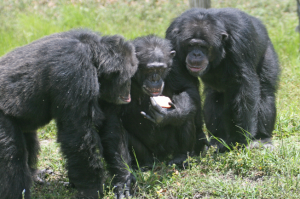By Leanne Bernstein

Do elephants experience empathy? Do artic foxes argue? Do narwhals negotiate? Do raccoons reconcile? Dr. Frans de Waal explores these ideas in his recent book, Mama’s Last Hug: Animal Emotions and What They Tell Us about Ourselves. Dr. de Waal, a Dutch-American biologist and primatologist, has been studying animal emotions for decades. In this book and in many other publications and studies, Dr. de Waal sets forth great evidence that animals do indeed experience a wide range of feelings and emotions in the same way that humans do. He argues that emotions help individuals to adapt and survive because they help animals and humans alike to facilitate better relationships and resolve conflict without resorting to what instinct may tell us to do. Emotions and feelings are the mechanisms which allow us to see our situations more broadly, contemplate the experiences of others, consider multiple scenarios, apply new information, and anticipate future outcomes. In other words, emotions give us the ability to collaborate and the desire to come to consensus with those around us. Studying emotions in animals and acknowledging the evolutionary roots of peacemaking and dispute resolution allows us to examine our own behaviors on a deeper level.
Get notified when new articles are posted to the EDR blog – sign up for our email list »
For a long time, there has been a struggle within the scientific community to define emotion, and this has made it a difficult thing to recognize in animals. How can we attribute emotions to non-linguistic beings when we have a hard enough time communicating them for ourselves? Dr. de Waal attributes some of this difficulty to the ambiguity between feelings and emotions—both playing a very important and related role in behavior. Feelings are internal and can only be known to the one that experiences them, unless they are communicated to another. Feelings are your internal thoughts about your coworker, your reflection on the meal your partner prepared last night, or your speculation about a presentation you have to do next week. Emotions, on the other hand, are physical and mental states that are a reaction to a situation and typically prompt an action. Emotions can be detected. They result in sweaty palms, a blushed face, wide eyes, or a giggle. Emotions can also be measured in both humans and animals by assessing hormone levels, such as cortisol which is released in response to stress, or oxytocin which is released in response to more positive emotions, such as joy or love. The fact that these hormonal responses to stimuli are essentially identical in both humans and animals is pretty good evidence that we experience emotions in similar ways. Examining how an animal responds to its emotions can shed light on how and why humans respond to their emotions.
While many emotions can be measured, the feelings behind them may be harder to get to, particularly because humans are notorious for faking emotions in order to hide their feelings. Remember when you smiled widely even though the meal your partner made was bitter and undercooked? Or when you laughed at your co-worker’s joke when you didn’t get it? It turns out that animals can fake emotional reactions as well. This is directly contrary to how we thought animals behaved for so long. Science had previously reserved the experience of emotions as strictly human (even though human emotions were also largely ignored in science until relatively recently), and believed that animals act purely on instinct. In other words, it was thought that animal actions are simply reactions to certain situations that are most likely to ensure survival, lead to more resources, or find a mate. So why then, would an animal fake an emotion or act in any way that is contrary to what instinct would tell them to? It turns out, for likely the same reasons that humans do. Dr. de Waal makes the case that feelings and emotions allow animals and humans to assess a situation and determine the most appropriate response based on context. Hardwired instinct is simply too fixed to allow for this. As Dr. de Waal puts it, they “are our body’s way of ensuring we do what’s best for us.” Our ability to manipulate our own emotions in order to hide how we’re feeling, whether we can do so successfully or not, can be malicious. But it can help us to maintain relationships, just like it does for animals. By reserving the expression of your true and immediate feeling, you can continue to analyze the situation and create a politer way to let your partner know that you will do more of the cooking moving forward.
It is now clear, even within the scientific community, that all social animals actively participate in peacemaking or other reconciliation behaviors, just like humans do. These behaviors are essential to keeping social units together. For example, Dr. de Waal elaborates on a situation he witnessed while observing chimpanzees in the wild. Drawn by the raucous commotion made by a group of chimps, Dr. de Waal watched as the group focused in on one chimp who was in possession of a recent kill. The commotion was made by the other chimps’ eagerness to share in the bounty. Contrary to what instinct or the principles of survival of the fittest might tell us, the possessor of the fresh meat shared his dinner with the other apes. Did he know it would be easier to share then to fight off the other chimps? Did he empathize with their hunger? Was he acting altruistically? Sharing, in this situation, may be beneficial in the long run because it maintains positive relationships between these chimps. The possessor of the meal likely understood this broad context and warded off his gut reaction to run or fight for his dinner. Emotions provide us with the ability to feel multiple things at once, analyze compounding factors, and empathize with others. It is for this reason that we should consider allowing more space for feelings into conflict resolution processes. Although it might seem a bit messy at times, embracing feelings and emotions will allow us to harness the creative and relationship-building powers that we are pre-programmed with.
Many classic negotiation tactics, dispute resolution protocols, and traditional business practices aim to rely purely on objective information, strict procedures, or ingrained power dynamics, in an attempt to eliminate the feeling-factor. While there may be a place and time for these methods, they lack recognition and consideration for the most salient aspects of the human experience: emotions. With the growing evidence for animal emotions, it is hard to deny that there is an evolutionary aspect to emotions, to social relationships, and to the benefits of conflict resolution, reconciliation, and peacemaking. Maybe it’s time we reconsider the civilized institutions and behaviors that we thought made us so different from our non-human relatives and appreciate what we have in common—a deep need for healthy social bonds that is guided by emotion and allows us to think critically about our situations.
Maybe we should be collaborating more like chimps.
Special thanks to Michele Straube for the inspiration for this piece.

Leanne Bernstein is a Master’s student in the City and Metropolitan Planning Department at the University of Utah. She is currently working with the Environmental Dispute Resolution Program as a Graduate Student Fellow.
